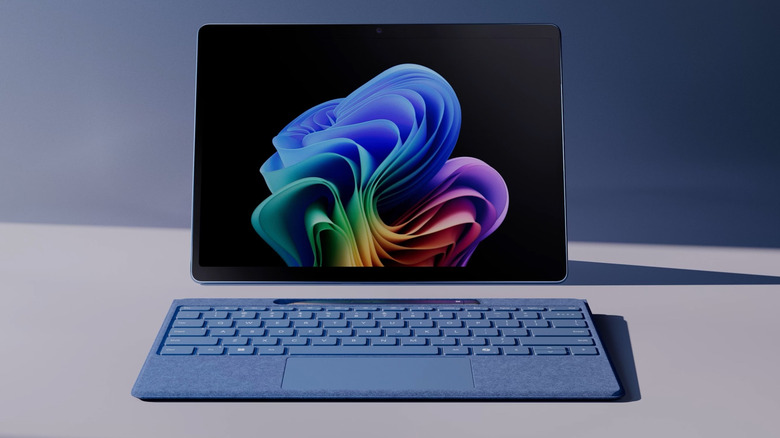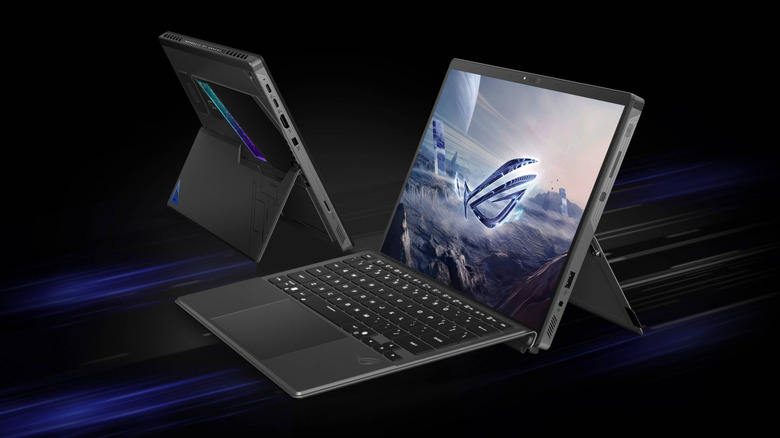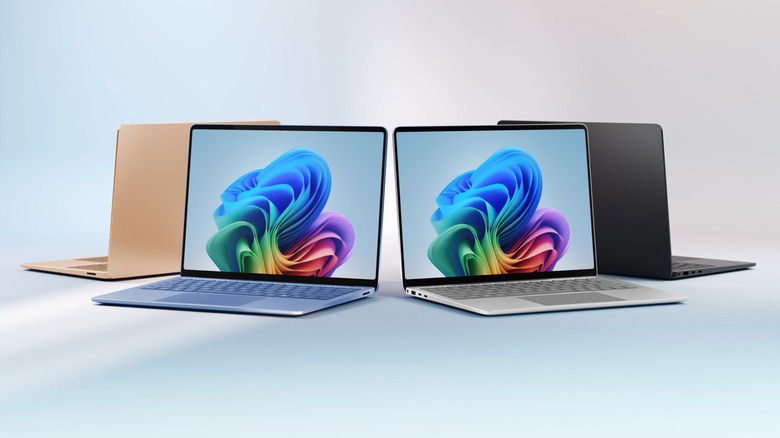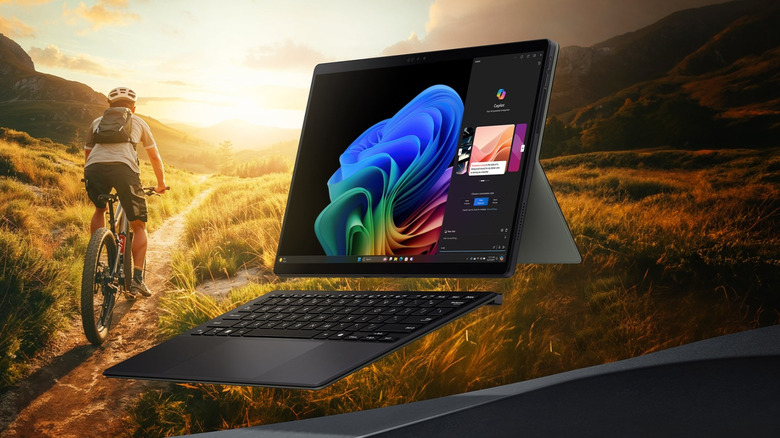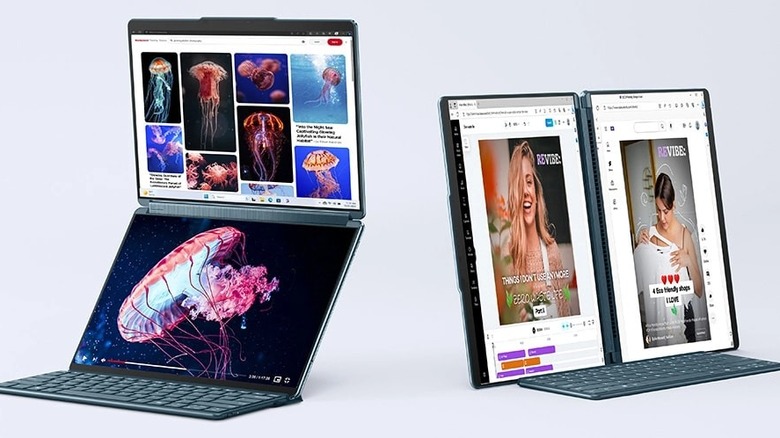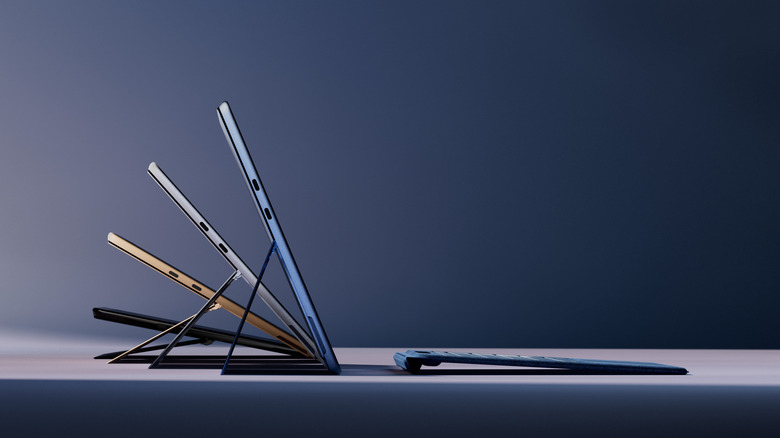4 Microsoft Surface Pro Alternatives For Windows Users
We may receive a commission on purchases made from links.
Since 2012, Microsoft has maintained its line of Surface laptops to act as standard-bearers for Windows laptops. The flagship Surface has always maintained a uniquely compelling form factor as a tablet that pulls double laptop duty when its keyboard accessory is attached. The devices are popular among students and creatives, and the newest, 11th-generation Surface Pro kicked things up a notch by rivaling Apple's beloved MacBook lineup with an ARM-based Snapdragon processor. But as premium as the Surface Pro is, it's also undeniably expensive once you factor in the cost of its keyboard, which is sold separately. And that fancy new processor? Many software developers haven't yet updated their apps for it.
However, the beauty of the Windows ecosystem is that you don't have to stick with Microsoft's hardware, as third-party manufacturers often offer something a little more specific to your needs. As one of SlashGear's resident Windows and laptop experts, with nearly two decades of experience in purchasing, repairing, and tracking the latest hardware, I've combed through spec sheets and reviews to identify four of the most appealing alternatives to the 11th generation Microsoft Surface Pro.
There are a few reasons someone might want a Surface Pro alternative, and I've hopefully covered the major ones. You might dislike the relatively high price, the unconventional form factor, or maybe you want different specs. So, here are four great alternatives to consider if the Surface Pro isn't quite right for you.
The premium alternative: ASUS ROG Flow Z13
If you love the Surface Pro's unconventional form factor, but you don't want to make the jump to an ARM processor, ASUS has you covered with the ROG Flow Z13. It's a tablet-style laptop with a detachable keyboard, but it's packing some serious, gaming tier components. The big drawback here is the price, which starts at an MSRP of $2,100 and goes up to $2,800 for the 2025 model, depending on configuration. Hey, at least you don't have to buy the keyboard separately.
For your buku bucks, you'll get an AMD Ryzen AI MAX 390 or MAX+ 395 processor. It's an APU, meaning a combination CPU and GPU rolled into one, and it's been the first chip to put a dent in the idea that integrated laptop graphics are always bad. To the contrary, while it won't give an NVIDIA GeForce RTX 5090 a run for its money, it can still play demanding titles like "Cyberpunk 2077" at Ultra settings with over 30 FPS (albeit with upscaling), according to Ars Technica's review. That's better than a lot of laptops with discrete GPUs. Throw in a respectably pixel-dense 2.5K IPS display and between 32 and 128 gigabytes of RAM, and you've got some serious mobile horsepower for gaming, design, editing, AI work, and more.
Our Adam Doud mostly liked but couldn't quite recommend the ROG Flow Z13 in SlashGear's review, though he chalked that up to its form factor. Of course, it's safe to say anyone buying this thing over a similarly configured clamshell laptop is purchasing it for that form factor. What's undeniable is the eye-catching design, which will appeal to those who like eye-catching gamer gear, but will probably turn off those in search of simplicity.
The clamshell alternative: Microsoft Surface Laptop 7th Edition
If you're looking for something similar to the Surface Pro but are turned off by its hybrid form factor, the obvious alternative is the Surface Laptop 7th Edition that bowed alongside it. Aside from a lack of OLED availability in the display and a slightly worse webcam, the Surface Laptop has nearly identical specs to its sibling in the Surface lineup in some regards, makes slight improvements to others, and is more affordable, too.
Like the Surface Pro, the Surface Laptop can be configured with a Qualcomm Snapdragon X Plus or X Elite chipset and up to 64 gigabytes of RAM and a terabyte of storage. It has a larger screen, at 13.8 inches compared to the Pro's 13 inches, but unlike the Pro, which comes with an OLED panel if you get the better Elite chip, the Laptop only comes in an IPS variety. It also swaps the Pro's 4K webcam for a 1080p unit. However, Microsoft rates it for 6 more hours of battery life, at 20 hours in total against the Pro's 14 hours, and in addition to the two USB-C ports found on the Pro, the Laptop tacks on a Type-A port for the many peripherals that still use the older connection.
Reviews are mostly positive for the Surface Laptop, with WIRED loving its ability to support up to three 4K monitors and its robust battery life but not so thrilled with its price. While slightly cheaper than the Surface Pro (since there's no keyboard to buy separately), you'll still spend $1,000 at MSRP for the base configuration and up to $2,499 if you go all out.
The budget alternative: ASUS ProArt PZ13
If what's holding you back from snagging a Surface Pro is the price, which can get quickly out of hand with accessories, a great budget option is the ASUS ProArt PZ13. Not only does it retain the unique, tablet-style form factor of the Surface Pro, but it adds some welcome features to the mix, all without breaking the bank. Best of all, the keyboard is included in its $1,100 MSRP, though a stylus will cost extra.
What immediately stands out as unique about the ProArt PZ13 is that it comes with an IP52 dust and water resistance rating, which means light protection from dust and vertically falling droplets of water. That's not even close to the protection you'd get with, say, a new smartphone, but it's more than most laptops bother with. Internally, the PZ13 sports a Qualcomm Snapdragon X Plus chip coupled with 16 gigabytes of RAM, which is identical to that found in the base config of the Surface Pro. It outdoes the Pro with storage, however, by packing a 1 terabyte SSD. A lot of devices would skimp out on the display to hit a lower price than the competition, but the PZ13 flips the script, shipping with a succulent OLED panel at a 3K resolution. I/O selection is also (slightly) better, with two USB-C ports, but also an SD Express card reader.
Reviews have been mostly positive, with SlashGear's review of the ProArt PZ13 griping that the kickstand is a detachable accessory but praising the fun-feeling design, high-quality display, and excellent battery life. PC Mag was slightly more favorable, as was Tom's Guide, with both publications awarding four out of five stars, though they worried about ARM compatibility issues that accompany all Snapdragon-powered Windows laptops.
The multitasking alternative: Lenovo Yoga Book 9i
If you're interested in a Surface Pro but your main frustration is that the small screen size makes multitasking a pain, let me introduce you to a remarkably strange alternative. The Lenovo Yoga Book 9i is a wildly inventive laptop that unfolds to reveal an extra screen and a detachable keyboard. Think of it like a dual-screen Surface Pro, but with x86 guts and an included keyboard, stylus, mouse, and stand. It's pricey at $2,000 MSRP, but given its one-of-a-kind design, that's somewhat expected.
Inside, the Yoga Book 9i packs an Intel Core Ultra 7 155U processor with integrated graphics, 16 gigabytes of impressive LPDDR5X RAM clocked at 7,467 megatransfers per second (which is good, because the memory is unfortunately soldered and therefore non-upgradable), and 1 terabyte of M.2 storage. Those internals drive two 13.3-inch, 2.8K OLED panels running at 60 hertz with HDR support. This package is clearly skewed toward office and productivity work, so you won't be doing any serious gaming or graphic design work on this laptop. Versatility of form is its strong suit, befitting the Yoga name, as it can be used with both screens side by side, one atop the other, or in a more conventional laptop mode with the keyboard snapping into place over the bottom display while the lower half of that panel functions as a trackpad.
Reviews for the Yoga Book 9i have been mostly great, though one common pain point is the lack of I/O. You get three Thunderbolt USB-C ports, which is still one more than the Surface Pro. SlashGear's review of this double-screened clamshell awarded it an eight out of ten, and ZDNET was in line, scoring it four out of five.
How these devices were selected
To ensure compliance with SlashGear's rigorous editorial standards, each of the Windows devices in this roundup was selected based on a meticulous analysis of their specifications, professional reviews, and the expertise of this writer. As indicated, they were selected with an eye toward their relative ability to substitute the 2024 Microsoft Surface Pro. Therefore, the above are not necessarily the best devices overall. They are rather the best within the scope of the applied criteria, as determined by the subjective evaluation of the writer. Additionally, these products may not represent the full spectrum of devices that could be classified as the best alternatives to the Microsoft Surface Pro, as we cannot guarantee that every device available on the market was considered. This article should not be considered as definitive, but rather as one resource among many available to consumers.
